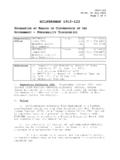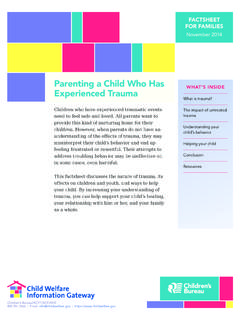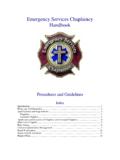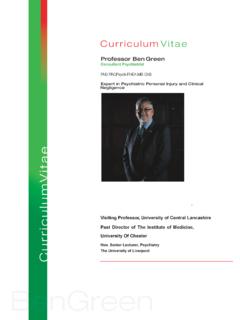Transcription of Violence and disasters - World Health Organization
1 Is Violence a problem after disasters ? iolence is an important issue facing communities affected by natural disasters , though the full extent of the problem has not been thoroughly studied. Immediately following a disaster, concerns about injuries, infectious diseases and the provision of basic needs take precedence over the surveillance of Violence . Studies of post-disaster Violence rates are few and are mainly from the USA. Anecdotal evidence and a small number of systematic studies indicate that intimate partner Violence , child abuse and sexual Violence are highly prevalent after disasters . Additional evidence suggests that the long-term effects of a disaster can lead to increased levels of crime and community Violence . Elder abuse, youth Violence and Violence related to the distribution of emergency aid have not been studied systematically but are likely to affect communities after a disaster.
2 What factors might contribute to increases in Violence after disasters ? disasters disrupt the physical and social environments that shape Health and Health problems, including Violence . Few studies have compared Violence levels before and after a disaster, but the effects of disasters are likely to increase individuals', families' and communities' vulnerability to violence1. These effects can have both an immediate and a long-term impact on Violence . increased stress and feelings of powerlessness due to bereavement, loss of property and loss of livelihood; mental Health problems such as post-traumatic stress disorder; the scarcity of basic provisions; destruction of social networks; 1 For more information on risk factors for Violence , see the World report on Violence and Health (WHO, 2002, ).
3 Breakdown of law enforcement; Violence and disasters cessation of Violence prevention and other social support programmes; disruptions to the economy. What types of Violence are likely to increase after a disaster? Child abuse and neglect. There is evidence that severe child abuse may increase after a natural disaster. Inflicted traumatic brain injury (TBI) is one of the most severe forms of child abuse, often leading to hospitalization and even death. In the six month period after Hurricane Floyd hit North Carolina, USA, the rate of inflicted TBI in children under two showed a fivefold increase in counties severely affected by the hurricane, while in counties less affected or not affected, there was no increase in the rate. Other studies have also shown post-disaster increases in child abuse reports. Intimate partner Violence and sexual Violence .
4 Increases in intimate partner Violence levels have been reported in the Philippines after the Mt. Pinatubo eruption, in Nicaragua after Hurricane Mitch, in the USA after the Loma Prieta earthquake and the eruption of Mt. Saint Helens, and in several refugee camps worldwide. Women who were living in a violent relationship before the disaster may experience Violence of increasing severity post-disaster, as they may be separated from family, friends and other support systems that previously offered them some measure of protection. After a disaster these women may be forced to rely on a perpetrator for survival or access to services. Displaced women and children are often at risk of sexual Violence as they try to meet their basic needs. Rape of women and children collecting water and firewood has been reported in refugee camps in Guinea and the United Republic of Tanzania.
5 Exploitation, including sexual exploitation. In areas where human trafficking is widely prevalent, disasters may result in conditions that provide opportunities for traffickers ( large numbers of unaccompanied children). Sexual exploitation may increase in situations where women's options for employment are diminished. Additionally, reports from the eastern Congo and Guinea V show that refugee and displaced women and children may be coerced into sex in exchange for food or shelter for themselves or their families. In cultures with traditions of early marriage and dowry, adolescent girls' may face an increased risk of early and forced marriage because of poverty. Forced marriage can also be a consequence of disclosing sexual abuse. What can be done? In the acute phase Focus should be on caring for victims of Violence and on taking measures to prevent abuse and exploitation: Health service delivery must include care for survivors of rape.
6 This care should include at a minimum treatment of physical injuries, pregnancy prevention, treatment for sexually-transmitted infections, and, where appropriate, HIV post-exposure prophylaxis. Ideally, Health workers should be trained to identify victims of Violence and provide care that ensures their safety, privacy, confidentiality and dignity, and victims should be referred for counselling and other services. Displaced children should be registered so that children separated from their families and possibly orphaned can be identified and offered special care and protection, preferably with family members in their local communities. Women's access to resources and assistance should be ensured, and women must be made part of the response and distribution networks. During Recovery Those assisting a community with reconstruction should take into account that the physical and social disruption caused by a natural disaster may increase the likelihood of family, sexual and other types of Violence , and that previously-existing resources for victims of Violence may be damaged or no longer functioning.
7 The following steps can ensure the safety of the community and help preserve its ability to prevent and respond to Violence : Community networks and programmes that addressed Violence before the disaster should be identified, revitalized and strengthened through training and support. Efforts to address Violence must engage men, women and children of the affected community in the planning phase, taking care to get input from groups who tend to be overlooked in programme development, such as abused women and persons with disabilities. Violence should be included in any injury surveillance system that is established. Community education and awareness campaigns are useful for informing residents how to report acts of Violence , what services are available and where they can go for care.
8 Campaigns can also be used to influence social and cultural norms related to Violence . Resources WHO and UNHCR. Clinical management of rape survivors (revised edition). 2005. UNHCR. Guidelines for prevention and response: sexual and gender-based Violence against refugees, returnees and internally displaced persons. 2003. RHRC Consortium/JSI Research and Training Institute. GBV checklist for the field. 2004. WHO and CDC. Injury Surveillance Guidelines. 2001. WHO. Guidelines for conducting community surveys on injuries and Violence . 2004. WHO Regional Office for South-East Asia. Gender-based Violence in disaster. Website. WHO. Gender and Health in disasters . 2002. Preventing Violence : implementing the recommendations of the World report on Violence and Health . World Health Organization , 2004. Contact World Health Organization Department of Injuries and Violence Prevention Geneva, Switzerland Email: World Health Organization , 2005 All rights reserved
















